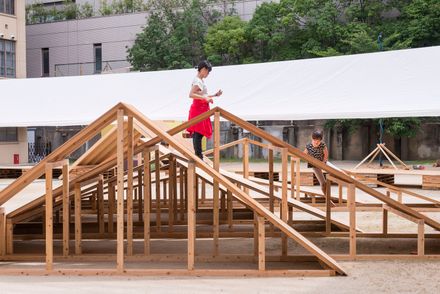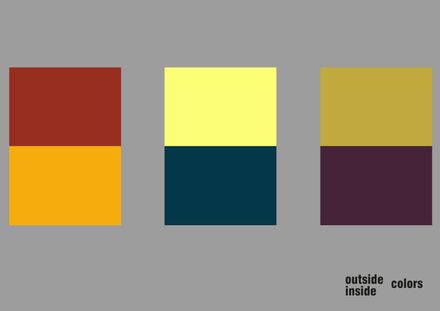LOCATION
Kyoto, Japan
CATEGORY
Museums & Exhibit, Installation
Text description provided by architect.
The village that appeared and disappeared in the school grounds of a former elementary school like a mirage at the end of summer. The extemporaneous exhibition was created in the schoolyard of a former school, founded by the donations of local citizen’s, now used as an art center.
The Kagerou Village, Kagerou meaning Mirage, was composed of a series of temporary pavilions designed and build by a group of architects from Germany, France and Japan.
Beforehand the six architects of different nationalities met, to discuss the potentials of the site and project, at a public symposium supervised by architectural historian, Taro Igarashi. Following the symposium, several meetings took place across the countries and it was decided to build the village of pavilions to create a series of practical public spaces in the rarely used schoolyard. dot architects.
All pavilions was built over a 5-day period, where dot architects acted as the main supervisor of the construction. Inspired by the successions of traditional roofs on the local Kyoto Townhouses ‘Kyomachiya‘, dot architects created a series of slides with different gradients to encourage play and pique children’s curiosity. They also build a sprinkler tower spraying mist to create a cool breeze.
Hiroshi Kato Connecting the sky and ground, Hiroshi Kato creatively took advantage of the site, by weaving several vinyl tapes across the open sky allowing them to cast striated marks on the ground where he designed humorous benches made of logs and weeds from the schoolyard. By doing this, he rendered the whole site into a huge room. When the sunshine falls and the wind blows into the courtyard, the shadows imitate the shape of rustling leaves.
The project and natural effects appeal to the visual and auditory senses, and relates to the local context the surrounding area with its long-established local textile wholesalers. Sébastien Martinez Barat and Benjamin Lafore The Welcoming folly, by Benjamin Lafore and Sébastien Martinez Barat, welcomed and guided the visitors with its layered patterns of stripes and curves, created by linear louvers interlocking at 90 degrees angels with curved planes and its shadows.
The louvers create patterns varying in size and gradient that engineer the whole structure, resulting in a space that creates an intimate room with complex shadows like fabric layers. Yo Shimada / Tato Architects Paying attention to the entrances of the two old school buildings facing each other, Yo Shimada chose to connect the two entrances with a long corridor like space, by stretching out a 6mx30m piece of agricultural fabric across the courtyard.
Beneath the fabric roof, a wooden deck invites to play, where kids can run back and forth, climb the raised path, which allows unobstructed passage between the two parts of the courtyard, touch the fabric and slide down on the other side.
The corridor resembles an ‘Engawa‘, the veranda of a Japanese Shrine, and invites visitors to take a nap, get-together or play.
Ludwig Heimbach In the far corner of the schoolyard, Ludwig Heimbach, joined a series of frames clad in plywood and fabric, creating a complex cabin structure where he intended for the visitors, lovers in particular, to engage in their secret conversations partly sheltered from playful kids.
The structure also functions as a drinking fountain for birds. In this way, the pavilion suggests that a public space should include various private areas and possibilities.
Sven Pfeiffer By erecting and drilling holes in a plywood structure, Sven Pfeiffer created an inverted bouldering pavilion titled ‘dangerous playground‘.
On the final day when this porous hideout was disassembled and staked into a pile, it too became a dangerous place to play.
As the name of Sven´s work ‘dangerous playground‘ suggests, the intention of Sven, Shimada and dot architects works was to arouse youth and vigor by providing ‘the potential playground danger‘ that Japanese public space generally excludes.
The use of fabric or it references is recurrent in the works, Shimada and Ludwig used fabric in cultural relation to the local textile wholesalers, Kato folded tapes like lacework, while Sébastien and Benjamin created overlaying shadows reminiscent of fabric.
The pavilions mutually influenced one another and as a whole created a village. One of the main discussions of the first symposium had been on the topic of prohibited matters in Japanese public spaces.
In this village that appeared and disappeared like a mirage, the thoughts was not ‘do not do‘ instead it became ‘what if we do?‘.
The Kagerou Village became a place children and adults alike could enjoy, despite the ‘dangers‘, allowing them to now subjectively raise questions as ‘if various things are doable, why not?‘. While an exhibition is a specific scenario, hopefully it becomes an opportunity to rethink the approach to public space from now on.






























